Botticelli's Oranges In an Italian port village near where the boy called "Allessandro" grew up, some thought his circles drawn must be made with a mechanical compass, so round, so fine, there in the Mediterranean sand, where Botticelli grew into youth, wandering through the orange and lemon groves of the Italian littoral; even then sketching lines of muscular trunks and extending arms branching into fingers of leaves, mixing into colors of rinds of reds and yellows. But when youthful fingers grew long enough to put a brush to canvas, he tinted the precious fruit In Madonna with Child and Angels, where she sat under blooming orange trees in spring, for the artist used orange trees to symbolize the virgin, because as he said: among fruits, only oranges are evergreen, "if one sees the mean." So on a Medici commission, Botticelli painted the ethereal La Primavera, there, the god Mercury stood in a grove of oranges, though some thought it looked like Lorenzo Medici's lustful hand reaching up to pick the ripe fruit. Then, came the historical day when the golden-haired Simonetta was ushered into Botticelli's studio by Lorenzo's sweaty hands, and Botticelli asked: Is she a reincarnated goddess from the Adriatic Sea? Soon, on Botticelli's easel, the canvas revealed the ravishing Simonetta turned into Venus herself, standing on a giant clam shell, surfing into the sun-swept coast of Italy, bringing to the world of mythology, those precious winter oranges to peel. Today, in the sea-side village of Porto Venere, the local men gather mornings under evergreen shade of orange-tree cafes, where citrus rind is mixed into the black coffee, and while the old men lament the lost wonder of their divine youth, sometimes foreign visitors overhear them to say: "Even in the arms of Venus, whom everyone knows brought the first citrus from China to Italy, oranges were never so well-designed and ripened as in the hands of the great Botticelli!" ** Dust Down a Long, Desert Road (Watching the classic movies in coronavirus lockdown; watching again, in what may be the most powerful ending in cinematic history—the final scene of Lawrence of Arabia) Some believe that keen minds may foresee their last day on earth, and in the passenger seat, a British officer stares into a dusty windshield that reflects a weary face marked with deep lines of departure—faded, blue eyes that saw too much sun in a dirty, desert war—now riding in a motor car, burning oil to fuel what's called the new internal-combustion engine. A soldier-warrior leaving the region of an empire closing down, a place where none back in London will ever understand how the mind and body adapts to a land this harsh, an ambience where heat soars beyond even a sauna's possibility—his life now in transition, leaving years of Bedouin life, beyond European imagination—yet the quintessence of freedom, living in the pages of the Old Testament's truth, his stained war memories flashing past— rocky valleys, date-palm oases, and vast sandy stretches—gargantuan boulders rise into an atmosphere too scorching for clouds to rain. Finally, the chauffeur, seeing Lawrence taciturn and glum, tries to make conversation: —Going home sir? —Home? —Must be glad to leave this desert hell. —As you say. —I've heard it say…a Victoria Cross waits you back in the U.K. Laurels for the empire's victors—how little they mean when a dirty war is remembered and so many comrades dead, while dust continues to whirl under their wheels, but as they turn a corner, crossing before their motorcar, blocking the road—a herd of feral camels. The driver curses, blows his horn, but Lawrence, still grounded in Arabia, raises his officer's hand. —Driver, let them pass. —Them stinking beasts, sir? —We have no hurry. When their motor car drives on, Lawrence cannot resist standing up—a last look back at the camels and dust fading into memories of shifting sands and blood-soaked years and centuries—dunes where they slept out under the burning stars—when knights and tribal kings led armies on raids, mounted on endurance camels and racing Arabian horses across these deserts to attack seaside forts and enemy garrisons—fighting with swords and daggers—and as the road winds on, Lawrence recalls Charles Doughty's "Arabia Deserta," where the fires of deserts will turn even hardened warriors into prophets. Lawrence gazes too long back at Arabia of legend, riding in the saddle, wearing the silken, white robes of a knight, crossing Sinai on a camel, riding through history's books. Recalling he stepped high in the stirrups, turning to his bedouin companion, who pointed at the horizon. —There! A pillar of fire! —Now we see what Moses saw! Lawrence of Arabia rides on down the final road; he realizes the alienated paradigm taking place—what displaces camels and horses with oil-burning machines and internal combustion engines that rolled out lethal armored tanks and flew "aeroplanes" and made war in the Middle East, which armageddon had long foretold— when a wind-gust brings the screaming racket of a motor- cycle passing their car—dangerously fast—tires throwing back loose pebbles, one cracking the windshield glass. Through the broken glass, Lawrence squints to see the motorcyclist, but visualizes his own reflection on the back of the vanishing rider—remembering suddenly what the desert sages foretold long ago in their ancient scripts: only the chosen few know how their destiny ends but only for the few will destiny ever exist. ** The Artist's Garden at Giverny—a painting In Monet's The Artist's Garden at Giverny, the eye drifts from left to right—follows a clay path, slipping, sliding further on 'til in the middle, the morass of color blooms— then slanting further right, we see in the distance behind, the house where Monet lived, but used mostly just for sleep, where it's said the artist's impressionistic dreams revealed qualities of the Japanese aesthetic, inherent in the power of light, always changing, where the simplicity of wabi shading variegated greens of lichens, on the bark of the scaling bark of evergreen pines, and the grass, foregrounded by the clay path, leading to the impermanence of sabi, where deciduous trees remain leafless, though the spectator sees a canopy, over- dappling sun shedding the side of the canvas and colors darken, yet brighten purple and lavender lilies to the right, which suggests the refined aesthetics of miyabi—ripe roses and tulips in bloom, the quintessence of floral beauty includes the burgundy and blue iris that dominate the dramatic colors of the garden, the red peonies, secondary behind, the pale sunlight on the painting's left side, but still the disharmony of shibui objects placed off center— of the three trees to left—one to right, the rule of thirds, or call it two-thirds, it's been painted and placed since Heian classical times, after all, it's no secret that wild flowers usually have 5 petals, but iki showing the refined uniqueness of a multi- petaled rose or orchid or camelia hanging, and then we see the yugen—something unexplained—the smoke we remember behind Hiroshige's mysterious smoke drifting up and to the left of the red volcano, Mt. Fuji, But why is Monet's path blocked? Ironical that we cannot walk—just an illusion where the garden visitor can amble left? Is the path truly thwarted? Or is this path not designed for strolling, but perhaps is just Monet's plan for a "mise en scene" to connect where the yugen combines with the johakyu? The eye keeps accelerating and cruising through the many multi colors like a dragonfly or butterfly to reach where all paths and all roads end in the ensou—the void, as we remember that Zen conceals what we visualize, and all we praise of beauty that's ephemeral and passing before us like a full moon before the blind nights of dark holes return. But some paths pass through the petals and sepals of perennials, and highlights of annuals that grow along the exposed earth that Monet abhorred, yet opens up this exquisite spectacle, where the impression is not just the design of aesthetic floral form but the eye that keeps rolling and the changing light seen by a divine hand, where in the end color, form, design become one, since never was the theory of impressionism and the cultivation of beauty so successful where color, form, and design prove that all that we perceive is an illusion—less of eyes, more of mind.
***

Reed Venrick studied Italian at the Italian University for Foreigners in Perugia; French at the Alliance Francaise in Paris, and taught English for a year in Saudi Arabia, where he first read the books of T.E. Lawrence.


